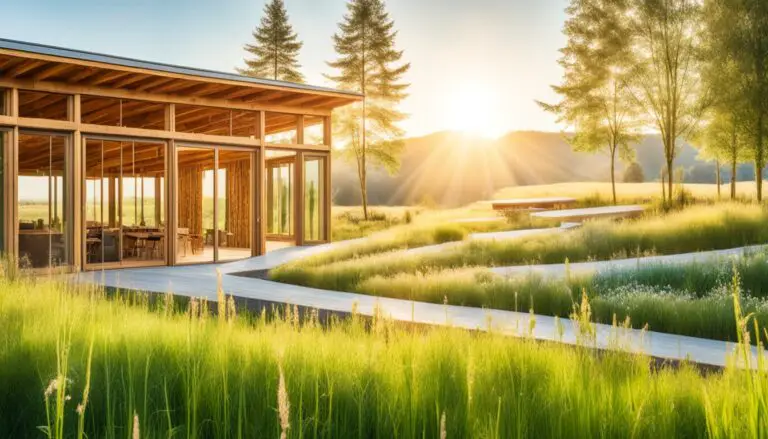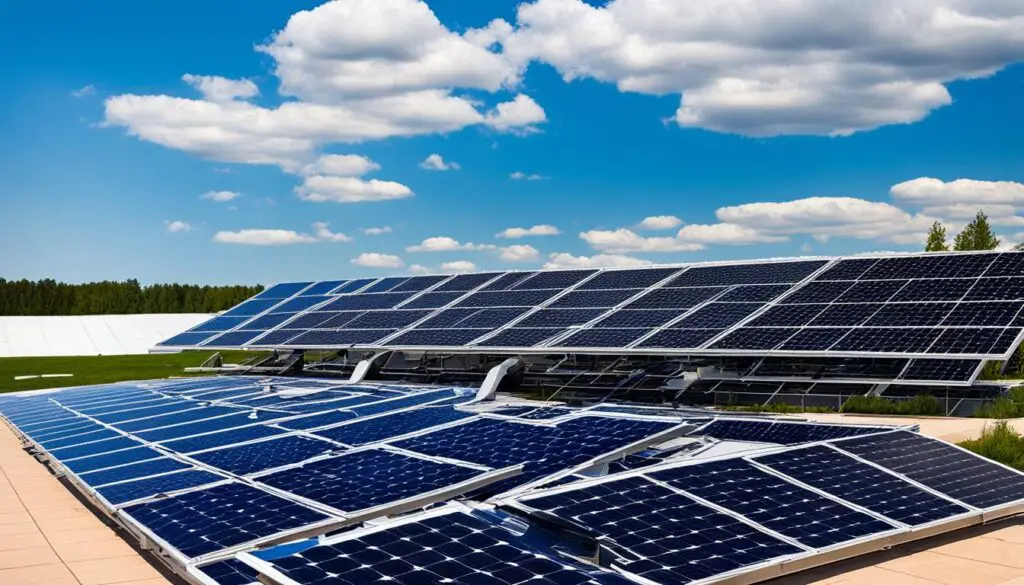Sustainability is now a top priority in today’s world. The rise of climate change makes it clear that we need to act green. Sustainable building is one way to make a big difference. By choosing green building materials, we can lower the harm done to our planet. This also means we create spaces that are good for our health and save energy.
Key Takeaways:
- Green building materials contribute to environmental sustainability.
- Using sustainable materials improves energy efficiency.
- These materials help reduce waste and conserve natural resources.
- Indoor air quality is improved with the use of green building materials.
- Sustainable construction practices support a greener and healthier future.
The Benefits of Using Green Building Materials
Using green building materials offers many advantages for sustainable building. These materials are eco-friendly and boost energy use, indoor air quality, and reduce waste. They help conserve natural resources too. By choosing green materials, we make spaces that look good and are better for our planet.
Improved Energy Efficiency
Green materials greatly improve energy efficiency. They are made to keep heat in or out, so we use less energy for heating and cooling. This means buildings stay comfortable without much energy use. People living or working there pay less for energy and use less fossil fuel, making for a healthier planet.
Better Indoor Air Quality
These materials also better the air inside buildings. Unlike traditional materials, they don’t release harmful chemicals. For example, insulation from natural fibers and safer adhesives reduce chemical levels in the air. This creates a healthier environment for everyone inside.
Conservation of Natural Resources
Green materials save our natural resources. They often come from recycled or renewable sources. They also last longer, meaning less waste. This careful use of resources saves for future generations and cuts down on waste.
Reduced Waste
They also mean less construction waste. Materials like recycled steel or wood keep waste out of landfills. Because they last longer, there’s less need to replace them. This cuts down on waste over the building’s life.
In summary, green building materials offer clear benefits. They save energy, improve air quality inside, save natural resources, and reduce waste. Using these materials makes for buildings that are good for both people and the planet.
Types of Green Building Materials
There are many types of green building materials for eco-friendly construction. They help make our world greener. These materials reduce environmental impact and enhance energy efficiency.
Sustainable Timber
Sustainable timber comes from well-managed forests. It follows eco-friendly practices, preserving forests and biodiversity. This makes it a top choice for building because it’s renewable and versatile.
Recycled Steel
Recycled steel lessens the need for new steel. Using it in construction saves energy and raw materials. It’s also strong, lasting, and resistant to fire and corrosion.
Energy-Efficient Windows
Energy-efficient windows improve insulation and lower energy use. They use advanced technology for better thermal performance. This helps buildings use heating and cooling systems more effectively.
Natural Fiber Insulation
Insulation from natural fibers like wool or cotton is great for green buildings. These fibers help keep temperatures stable inside. They’re also non-toxic and enhance indoor air quality.
Solar Panels
Solar panels generate clean energy from the sun. Installing them reduces the need for fossil fuels. They lower energy costs and emissions, supporting a sustainable future.
Using green materials in construction is key for sustainability. It also boosts energy efficiency and indoor quality. Choosing materials like sustainable timber, recycled steel, energy-efficient windows, natural fiber insulation, and solar panels helps the environment.
| Green Building Material | Benefits |
|---|---|
| Sustainable Timber | Durable, versatile, renewable |
| Recycled Steel | Energy-saving, strong, corrosion-resistant |
| Energy-Efficient Windows | Improved insulation, reduced energy consumption |
| Natural Fiber Insulation | Effective thermal performance, non-toxic, improved indoor air quality |
| Solar Panels | Clean, renewable energy generation, reduced carbon emissions |
Conclusion
Green building practices are more crucial than ever as we aim for a healthier planet. They focus on sustainability and saving energy, water, and reducing waste. These actions help cut down on gases that warm the planet. They also save precious natural resources and make the air inside buildings cleaner.
Certifications like LEED and BREEAM are key in promoting green buildings. They check if buildings use eco-friendly practices and materials. This pushes the construction world to be more sustainable.
Projects like the Bullitt Center in Seattle and The Tree House in Houston show the power of green building. They prove that eco-friendly materials work well in real life. These buildings are not just good for the earth. They are also better spaces for people to live and work in.
The movement towards sustainable living is growing. Adopting green building practices is vital. They help us lessen our impact on the environment. And, they lead to more efficient buildings. This way, we’re helping not just ourselves, but also future generations.
FAQ
What are green building materials?
How do green building materials contribute to improved energy efficiency?
What are some examples of green building materials?
How do green building materials improve indoor air quality?
What are the environmental benefits of using green building materials?
Source Links
- https://www.mataverdedecking.com/blog/building-a-better-world-how-green-building-materials-benefit-the-environment
- https://www.linkedin.com/pulse/sustainable-building-practices-paving-way-greener-future-cameron-wick-k7nvc
- https://medium.com/@halimefiliz33/sustainable-construction-building-a-greener-future-7291a44755d



